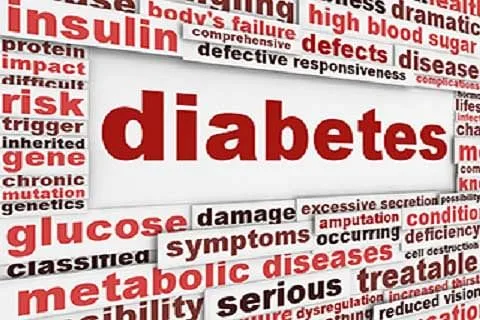Type 2 diabetes mellitus (T2DM) is an expanding global health problem accounting for more than 90% of all cases. It is closely linked to the epidemic of obesity. Formerly, it was known as adult-onset diabetes. T2DM is characterized by high blood glucose (hyperglycemia), dysregulation of carbohydrate, fat, and protein metabolism due to insulin resistance or relative lack of insulin. Individuals with T2DM are at high risk for both microvascular complications (including retinopathy, nephropathy, and neuropathy) and macrovascular complications (such as cardiovascular comorbidities), owing to hyperglycemia and individual components of the insulin resistance (metabolic) syndrome. Environmental factors (for example, obesity, an unhealthy diet, and physical inactivity) and genetic factors contribute to the multiple pathophysiological disturbances that are responsible for impaired glucose homeostasis in T2DM. Its main cause is progressively impaired insulin secretion by pancreatic β‑cells, usually upon a background of pre-existing insulin resistance in skeletal muscle, liver, and adipose tissue. Overt hyperglycemia is preceded by prediabetes, a high-risk condition that predisposes individuals to T2DM development.
Signs and symptoms
The symptoms of diabetes are frequent urination (polyuria), increased thirst (polydipsia), increased hunger (polyphagia), and weight loss. Other symptoms include a history of blurred vision, itchiness, peripheral neuropathy, recurrent vaginal infections, and fatigue. Many people, however, have no symptoms during the first few years and are diagnosed on routine testing.
Causes
The development of T2DM is caused by a combination of lifestyle and genetic factors. While some of these factors are under personal control like diet and obesity, other factors are not, such as increasing age, gender, and genetics
Lifestyle
Lifestyle plays an important role in the development of T2DM, including obesity and being overweight, lack of physical activity, poor diet, stress, and urbanization. Excess body fat, consumption of sugar-sweetened drinks in excess is associated with an increased risk. The type of fats in the diet is important, with saturated fats and trans-fatty acids (bad-fat) increasing the risk, and polyunsaturated and monounsaturated fat (good-fat) decreases the risk. Eating a lot of white rice appears to play a role in increasing the risk of T2DM.
Genetics
Most cases of diabetes involve many genes, with each being a small contributor to an increased probability of becoming a type 2 diabetic. The proportion of diabetes that is inherited is estimated at 72%
Diagnosis and prevention
Diagnosis
Currently, diabetes diagnosis is based on fasting blood glucose levels, post-glucose-load glucose, and HbA1c levels. T2DM diagnosis can be established based on an elevated random plasma glucose test (≥200 mg/dL), fasting plasma glucose levels (≥126 mg/dL), 2-hour post-glucose-load (≥200 mg/dL after 75 grams of oral glucose intake) or HbA1c (≥6.5%). More recently, HbA1c (glycated hemoglobin) has been added as an integrated measure of long-term glycaemia.
What is HbA1c
The term HbA1c refers to glycated hemoglobin. It develops when hemoglobin, a protein within red blood cells that carries oxygen throughout your body, joins with glucose in the blood, becoming ‘glycated’. By measuring HbA1c, clinicians can get an overall picture of what was the average blood sugar level for three months
Prevention
Randomized clinical trials have conclusively demonstrated that intensive lifestyle interventions and medications are effective in delaying or preventing the development of T2DM in high-risk individuals. Four large randomized, controlled clinical trials demonstrated that diet, moderate physical activity, and maintaining 5–7% body weight loss reduce T2DM risk by 29–58%. Lifestyle interventions are associated with improved quality of life across different ages, genders, and racial and ethnic groups, independent of the degree of obesity and hyperglycemia. Metformin reduces the risk by 26–31%, α-glucosidase inhibitors reduce risk by 25–41% and thiazolidinediones reduce risk by 55–72%.
Treatment
Antidiabetic drugs
Achievement of durable glycaemic control requires antidiabetic medications that reverse the pathophysiological defects that are present in T2DM. Because no single medication reverses the multiple abnormalities, combination therapy has gained widespread acceptance and will continue to grow. Normalization of HbA1c at the time of diagnosis results in improved long-term glycaemic control. For prediabetes, pharmacological therapy with thiazolidinediones, GLP1 receptor agonists, metformin, and AGIs effectively prevents or delays the progression of impaired glucose tolerance to diabetes.
Metformin
Metformin is the most commonly prescribed antidiabetic medication worldwide and works by suppressing hepatic glucose production, leading to a reduction in fasting plasma glucose levels and HbA1c.
Insulin sensitizers
Thiazolidinediones (like pioglitazone and rosiglitazone) are the only true insulin-sensitizing agents. They enhance insulin action in skeletal, cardiac muscle, liver, and adipocytes. It exerts a strong effect on β‑cells to increase and preserve insulin secretion.
Glucagon-like peptide (GLP1) modulators
T2DM is associated with severe GLP1 resistance in β-cells. Dipeptidyl peptidase 4 (DPP4) inhibitors (sitagliptin, saxagliptin, linagliptin, alogliptin, and vildagliptin) prolong the half-life of endogenously secreted GLP1. As DPP4 inhibitors do not increase (only prolong) plasma GLP1 levels, their ability to augment insulin secretion and reduce HbA1c is modest. Their primary effect to improve glycaemic control is mediated by inhibition of glucagon secretion and reduction in basal hepatic glucose production.
The treatment must not only be effective and safe but also improve the quality of life. Several novel medications are in development, but the greatest need is for agents that enhance insulin sensitivity, halt the progressive pancreatic β‑cell failure that is characteristic of T2DM and prevent or reverse the microvascular complications.Dr. Arif Bashir is a Ph.D. in Clinical Biochemistry and is presently a postdoctoral fellow working on Stem Cell Biology at IIIM, Jammu






